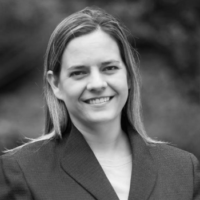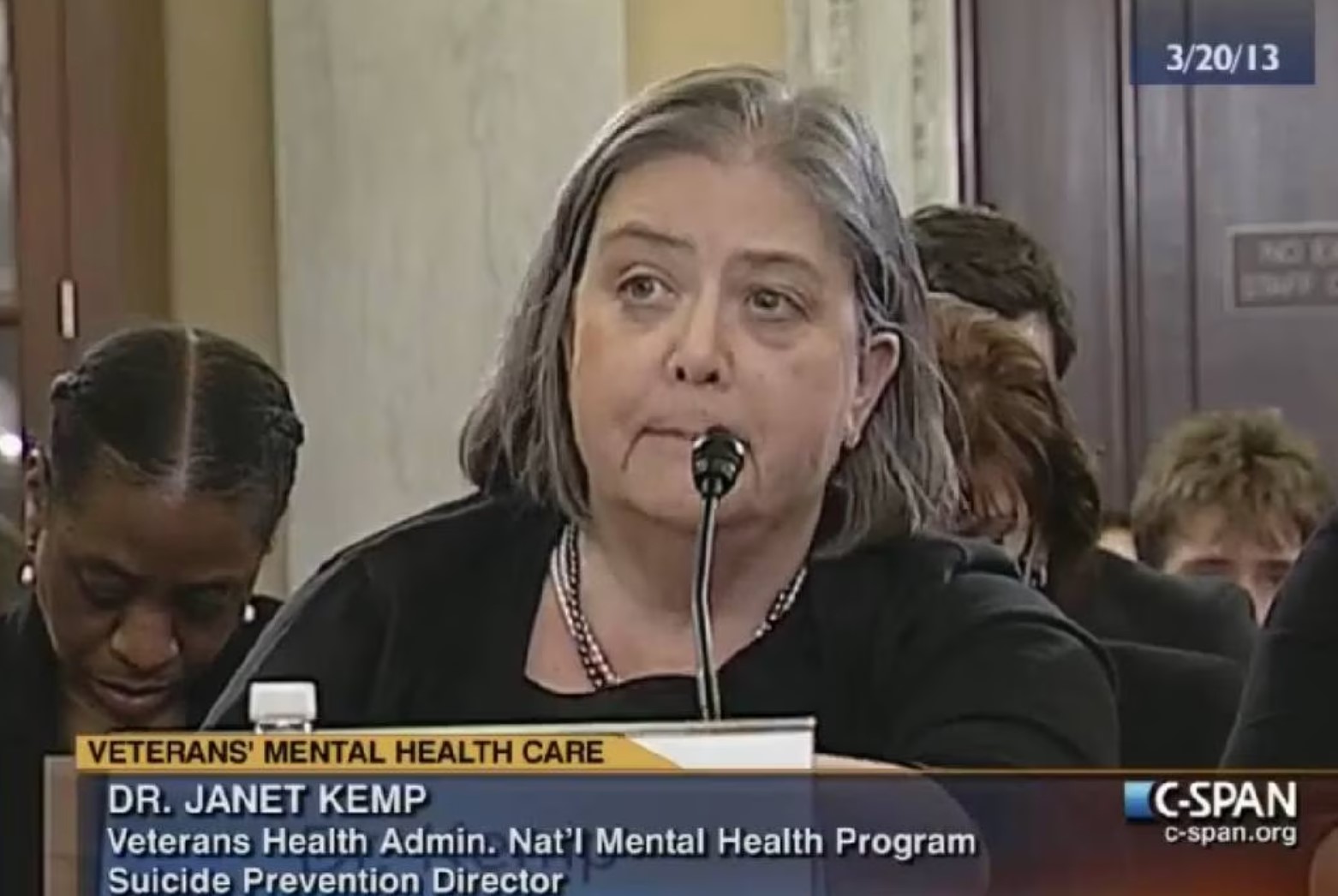News > This is My Life’s Work. To Prevent Veterans’ Suicide, Caitlin Thompson is Building Relationships that Bridge Science to Services
24 March 2023
To Prevent Veterans’ Suicide, Caitlin Thompson is Building Relationships that Bridge Science to Services
 “I can still hear her yelling in one ear, keeping me inspired, but also encouraging me to set my own course,” Dr. Caitlin Thompson says about her mentor, the late Dr. Janet Kemp. Jan, as colleagues knew her, led the charge in the VA’s early suicide prevention programming and left a legacy of inspired suicide prevention lifers, a community of people dedicating their careers to saving lives.
“I can still hear her yelling in one ear, keeping me inspired, but also encouraging me to set my own course,” Dr. Caitlin Thompson says about her mentor, the late Dr. Janet Kemp. Jan, as colleagues knew her, led the charge in the VA’s early suicide prevention programming and left a legacy of inspired suicide prevention lifers, a community of people dedicating their careers to saving lives.
While biotech and clinical research have transformed many medical fields, their application toward mental health care for veterans and those impacted by trauma lag behind. We’re at a turning point, and Polaris Genomics is fortunate that Caitlin joined the team in 2022 as Director of Strategic Partnerships. She’s harnessing her decades of experience and relationships in the field, focused on advancing veterans’ suicide prevention services through innovations in diagnostics for PTSD and other mental health conditions.

Image courtesy of https://www.militarytimes.com/
Here, Caitlin shares her story and why she is excited about Polaris Genomics’ efforts to revolutionize mental health care:
Q: What brought you to this field?
Caitlin Thompson: I am a licensed clinical psychologist. I had spent my grad school focused on female maximum security inmates, where I learned so much about trauma. I knew I wanted to learn more, so I decided to spend some time working with veterans. The first day I walked into the Denver VA Medical Center, I immediately felt a tremendous pulse of, “This is it.” What an honor to work with these men and women and be a part of this. I fell in love with the veterans population and felt compelled to find ways that we can serve them better.
I had originally gone to grad school to be a clinician. In 2005, my internship year at Denver, I worked with three individuals who all died by suicide that year, and it rocked my world. They were all men, all veterans, and all under 40. One had just recently returned from Iraq. I was floored. All I knew was that I had to get to the root of what was going on.
It just so happened that the Denver VA had started a postdoc program on suicide prevention that same year, so I was among the first few postdocs to join the program. This was my entrance into the suicide prevention world and where I have stayed.
It was there that I met Dr. Jan Kemp. She was a powerhouse. In the early 2000s, she was one of the first people to literally use an Excel spreadsheet and start counting veteran deaths by suicide, and she helped sound the alarm that something terrible was happening here. She threw her life into it: She was a workhorse, super-smart, a nurse by training, who had spent her early career in AIDS prevention.
My second-post doc was at the University of Rochester’s Center for the Study and Prevention of Suicide where I continued to learn more. It was a hotbed of people focused on suicide prevention research. While there, the VA had just started the Veterans Crisis Line (VCL), and Jan was looking for a clinical person to oversee the clinical work for the VCL. There were just 40 people on staff then, and there are around 1000 today. I spent five years immersed there, I did everything from working the phones to administration, so I could better understand and better manage every aspect of the program.
Eventually, I served in the role of Deputy Director under Jan to oversee the Suicide Prevention program at the VA, where I could help to manage policy. From witnessing tragic loss early in my career to deep diving into prevention, it has taken so much fortitude. I spent over 10 years at the VA, and I love the people who continue to work in this space. This set the course for my life. We have the potential to not just save lives but also improve the quality of their lives, It doesn’t get better than that.
It is an honor to be part of this fabric.
You know when you meet a team who is just in it for the right reasons? When I met the CEO of Polaris, Charles Cathlin, I was just like, “Yes, what can I do to help?”
Q: What keeps you grounded amid what can feel like an uphill battle?
Caitlin Thompson: One of the huge problems is that there is never enough time. But you cannot do the work without taking care of yourself. There’s a lot of discussion around this, and I am hopeful there are more policies to support people who are working in the suicide prevention community. There’s a lot of informal care and community support among us. Many of us are bonded as survivors of those who have lost someone.
Q: How have people received information about PTSD biomarkers and genomic diagnostics? How can we get ahead of the hotline, so the call doesn’t need to be made?
Caitlin Thompson: I’ve been in so many meetings where people have this ‘great idea,’ and the problem is that we’ve been there and done that. There is finally more focus on innovation, which is why I love the work that Polaris does. Really understanding the biological underpinnings of mental health from a genomic perspective has so much potential. People have honestly had varying outlooks from, “Holy cow, this sounds amazing,” to, “There is not enough work done yet to prove this.” So I say to them, let’s work on this together. That’s the work we need to do; therein lies the opportunity. We need to validate and collaborate. At the clinical and primary care level, people also need to know that it is one highly technical, objective tool in their toolbox, but it is not the end all be all. This does not replace clinical practice or personalized screenings with healthcare professionals, it ideally fast-tracks, and complements it.
Q: Living in the Covid era, have you seen opportunities arise from the way people look at biotech and mental health differently?
Caitlin Thompson: In-home diagnostics have benefitted us by educating the public on specialized care, especially for people like veterans who live in very rural, isolated areas, these people are some of the most vulnerable, and we can show them, “We see you, and you are not out there alone in the dark, we can come to you.” We can test them and bring them into a telehealth opportunity to get the care they need, and the care they deserve. I worry so much about these individuals – most often men – who are veterans who go to extremely remote areas to get away from it all, and sadly, they sit in this space of unhealthy reflection, lost without social support or healthcare. This is a way to challenge that and to support them.
Q: Why veterans? And once we overcome the veterans’ suicide crisis, what next?
Caitlin Thompson: Veterans are 1.5 times more likely to die by suicide than nonveteran adults. I don’t know anybody who would say that veterans are not worthy of this life-saving attention. This is a population I work with and will always work with, but I also want to point out the work that Polaris has done with other people who are not seen, like inner-city Baltimore, underserved populations like African Americans facing comorbid conditions of PTSD, and substance abuse disorder. Plus, suicide rates are rising, especially among young Black men and Native American populations. We see these giant red flags, and we don’t need an Excel spreadsheet to sound the alarm anymore; we need to support these populations with equity, upstream mental health care, earlier diagnosis, and a path to a better quality of life, a life without the chronic debilitating suffering from mental health disorders.
We are continuing where Jan left off, and with impassioned and smart business leaders like the Polaris team, we have the power to innovate and change the course, and head into a brighter place.
Q: What’s happening on the ground, day to day?
Caitlin Thompson: I am always trying to bring people together because others cannot do it all, and Polaris cannot do it all. To bridge these gaps is so fantastic. In terms of innovation and what it can look like, we need to move the needle of innovation, to get away from the same old, same old. We have to dually focus on things like food security and housing and, far upstream, pre-trauma. Getting away from the crisis, these things are so foundationally important, and we need to complement trauma response and crisis care with earlier preventative health and well-being, understanding it is an ecosystem, not always isolated instances.
Q: What’s your biggest hurdle, and how are you handling it?
Caitlin Thompson: I think that the biggest hurdle is skepticism about things that people don’t fully understand. But, I say, let’s figure it out and understand it! And that’s exactly what we’re doing. We’re disarming the doubt, and building an alliance of mission-driven professionals across key sectors, all moving forward with the belief that this is a mighty, accomplishable, and worthy goal that can be reached. I am honored to be part of the collective that is doing it.